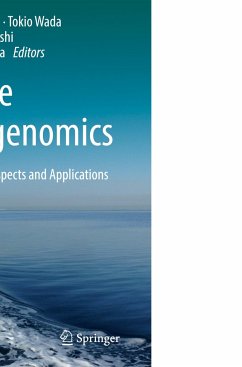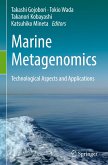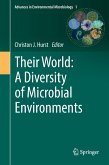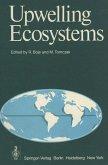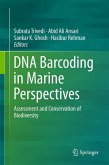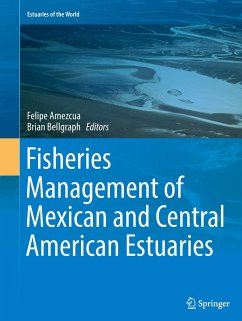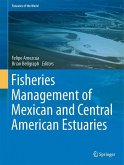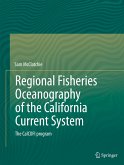Marine Metagenomics
Technological Aspects and Applications
Herausgegeben:Gojobori, Takashi; Wada, Tokio; Kobayashi, Takanori; Mineta, Katsuhiko
Marine Metagenomics
Technological Aspects and Applications
Herausgegeben:Gojobori, Takashi; Wada, Tokio; Kobayashi, Takanori; Mineta, Katsuhiko
- Broschiertes Buch
- Merkliste
- Auf die Merkliste
- Bewerten Bewerten
- Teilen
- Produkt teilen
- Produkterinnerung
- Produkterinnerung
This book presents the state-of-art marine metagenome research and explains the method of marine metagenomic analysis in an easy-to-understand manner. Changes in the marine environment due to global warming and pollution have become a major global problem. Maintaining a healthy marine ecosystem requires advanced environmental monitoring and assessment systems. As such, the book presents a novel metagenomic monitoring method, which has been developed for comprehensive analyses of the DNA of microorganisms living in seawater to further our understanding of the dynamics of the marine environment.…mehr
Andere Kunden interessierten sich auch für
![Marine Metagenomics Marine Metagenomics]() Marine Metagenomics75,99 €
Marine Metagenomics75,99 €![Their World: A Diversity of Microbial Environments Their World: A Diversity of Microbial Environments]() Their World: A Diversity of Microbial Environments112,99 €
Their World: A Diversity of Microbial Environments112,99 €![Upwelling Ecosystems Upwelling Ecosystems]() Upwelling Ecosystems81,99 €
Upwelling Ecosystems81,99 €![DNA Barcoding in Marine Perspectives DNA Barcoding in Marine Perspectives]() DNA Barcoding in Marine Perspectives112,99 €
DNA Barcoding in Marine Perspectives112,99 €![Fisheries Management of Mexican and Central American Estuaries Fisheries Management of Mexican and Central American Estuaries]() Fisheries Management of Mexican and Central American Estuaries75,99 €
Fisheries Management of Mexican and Central American Estuaries75,99 €![Fisheries Management of Mexican and Central American Estuaries Fisheries Management of Mexican and Central American Estuaries]() Fisheries Management of Mexican and Central American Estuaries75,99 €
Fisheries Management of Mexican and Central American Estuaries75,99 €![Regional Fisheries Oceanography of the California Current System Regional Fisheries Oceanography of the California Current System]() Sam McClatchieRegional Fisheries Oceanography of the California Current System112,99 €
Sam McClatchieRegional Fisheries Oceanography of the California Current System112,99 €-
-
-
This book presents the state-of-art marine metagenome research and explains the method of marine metagenomic analysis in an easy-to-understand manner.
Changes in the marine environment due to global warming and pollution have become a major global problem. Maintaining a healthy marine ecosystem requires advanced environmental monitoring and assessment systems. As such, the book presents a novel metagenomic monitoring method, which has been developed for comprehensive analyses of the DNA of microorganisms living in seawater to further our understanding of the dynamics of the marine environment. The book can be used as a primer for new researchers and as a manual on experimental methods.
Changes in the marine environment due to global warming and pollution have become a major global problem. Maintaining a healthy marine ecosystem requires advanced environmental monitoring and assessment systems. As such, the book presents a novel metagenomic monitoring method, which has been developed for comprehensive analyses of the DNA of microorganisms living in seawater to further our understanding of the dynamics of the marine environment. The book can be used as a primer for new researchers and as a manual on experimental methods.
Produktdetails
- Produktdetails
- Verlag: Springer / Springer Nature Singapore / Springer, Berlin
- Artikelnr. des Verlages: 978-981-13-8136-2
- 1st edition 2019
- Seitenzahl: 284
- Erscheinungstermin: 15. August 2020
- Englisch
- Abmessung: 235mm x 155mm x 15mm
- Gewicht: 495g
- ISBN-13: 9789811381362
- ISBN-10: 9811381364
- Artikelnr.: 59809670
- Herstellerkennzeichnung Die Herstellerinformationen sind derzeit nicht verfügbar.
- Verlag: Springer / Springer Nature Singapore / Springer, Berlin
- Artikelnr. des Verlages: 978-981-13-8136-2
- 1st edition 2019
- Seitenzahl: 284
- Erscheinungstermin: 15. August 2020
- Englisch
- Abmessung: 235mm x 155mm x 15mm
- Gewicht: 495g
- ISBN-13: 9789811381362
- ISBN-10: 9811381364
- Artikelnr.: 59809670
- Herstellerkennzeichnung Die Herstellerinformationen sind derzeit nicht verfügbar.
Takashi Gojobori Ph.D., King Abdullah University of Science and Technology, Computational Bioscience Research Center Tokio Wada Ph.D., Japan Fisheries Research and Education Agency Takanori Kobayashi Ph.D., Japan Fisheries Research and Education Agency Katsuhiko Mineta Ph.D., King Abdullah University of Science and Technology, Computational Bioscience Research Center
Part 1: Technological Aspects of Marine Metagenomics: Sample Collection and preparation methods.- Chapter 1: Metagenomic methods: from seawater to the database.- Chapter 2: Collection of microbial DNA from marine sediments.- Chapter 3: Primer design, evaluation of primer universality and estimation of identification power of amplicon sequences in silico.- Chapter 4: High coverage expression profiling (HiCEP) of microbial community genomes in the ocean.- Part 2: Technological Aspects of Marine Metagenomics: Metagenome Data Analysis.- Chapter 5: Introduction and application of Digital DNA Chip Analysis (DDCA) to metagenomic analysis.- Chapter 6: Horizontal gene transfer in marine environment: a technical perspective on metagenomics.- Chapter 7: MAPLE enables functional assessment of microbiota in various environments.- Part 3: Applications in Ocean and Fisheries Sciences: Diversity and Function of Microbial Community.- Chapter 8: Comparison of microscopic and PCR amplicon and shotgun metagenomic approaches applied to marine diatom communities.- Chapter 9: Seasonal dynamics of bacterial community composition in coastal seawater at Sendai Bay, Japan.- Chapter 10: Shotgun metagenome analyses: seasonality monitoring in Sendai Bay and search for red tide marker sequences.- Chapter 11: Distribution and community composition of ammonia-oxidizing archaea and bacteria in coastal sediments in response to sediment material gradients at Sendai Bay, Japan.- Chapter 12: Marine metagenomic sequence counts of reads assigned to taxa consistently proportionate to read counts obtained for per g of sea water sample.- Chapter 13: New aquaculture technology based on host-symbiotic co-metabolism.- Part 4: Applications in Ocean and Fisheries Sciences: Analysis of the Red Tide.- Chapter 14: Influences of diurnal sampling bias on fixed-point monitoring of plankton biodiversity determined using a massively parallel sequencing-based technique.- Chapter 15: Detection of microorganisms which show positive or negative correlations with red tide causing alga using a new time-series network model.
Part 1: Technological Aspects of Marine Metagenomics: Sample Collection and preparation methods.- Chapter 1: Metagenomic methods: from seawater to the database.- Chapter 2: Collection of microbial DNA from marine sediments.- Chapter 3: Primer design, evaluation of primer universality and estimation of identification power of amplicon sequences in silico.- Chapter 4: High coverage expression profiling (HiCEP) of microbial community genomes in the ocean.- Part 2: Technological Aspects of Marine Metagenomics: Metagenome Data Analysis.- Chapter 5: Introduction and application of Digital DNA Chip Analysis (DDCA) to metagenomic analysis.- Chapter 6: Horizontal gene transfer in marine environment: a technical perspective on metagenomics.- Chapter 7: MAPLE enables functional assessment of microbiota in various environments.- Part 3: Applications in Ocean and Fisheries Sciences: Diversity and Function of Microbial Community.- Chapter 8: Comparison of microscopic and PCR amplicon and shotgun metagenomic approaches applied to marine diatom communities.- Chapter 9: Seasonal dynamics of bacterial community composition in coastal seawater at Sendai Bay, Japan.- Chapter 10: Shotgun metagenome analyses: seasonality monitoring in Sendai Bay and search for red tide marker sequences.- Chapter 11: Distribution and community composition of ammonia-oxidizing archaea and bacteria in coastal sediments in response to sediment material gradients at Sendai Bay, Japan.- Chapter 12: Marine metagenomic sequence counts of reads assigned to taxa consistently proportionate to read counts obtained for per g of sea water sample.- Chapter 13: New aquaculture technology based on host-symbiotic co-metabolism.- Part 4: Applications in Ocean and Fisheries Sciences: Analysis of the Red Tide.- Chapter 14: Influences of diurnal sampling bias on fixed-point monitoring of plankton biodiversity determined using a massively parallel sequencing-based technique.- Chapter 15: Detection of microorganisms which show positive or negative correlations with red tide causing alga using a new time-series network model.

